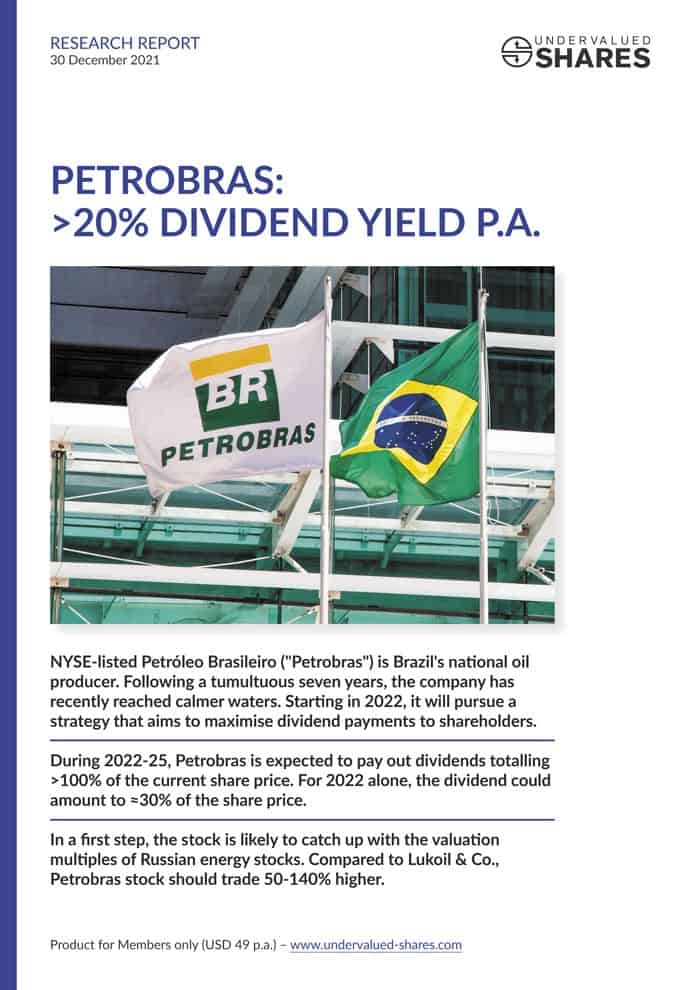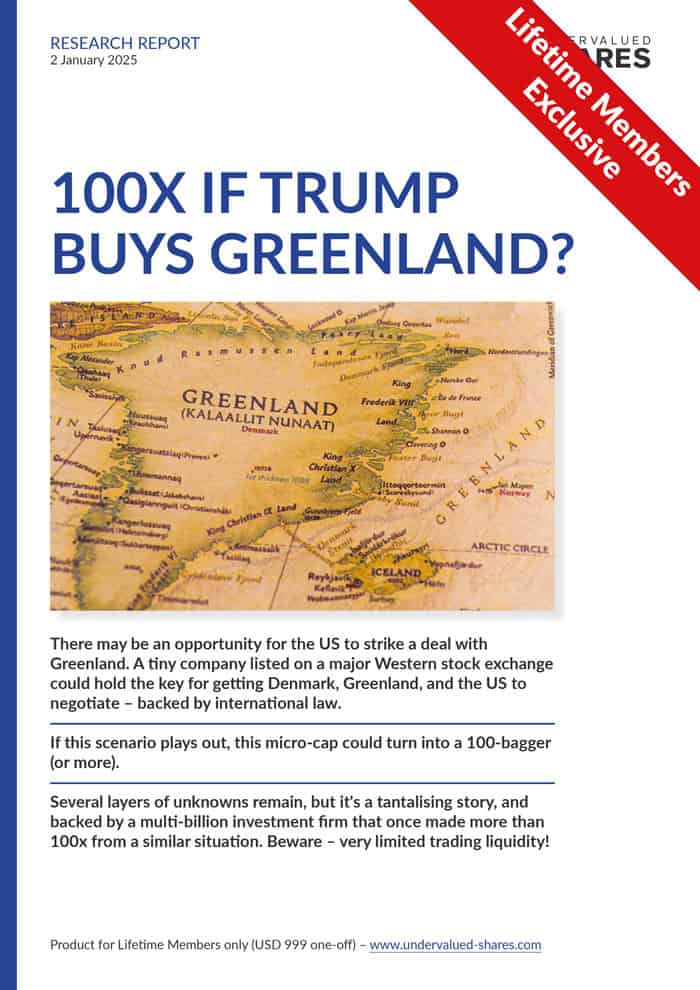No one wants to invest in coal anymore – or so they say.
The opposite seems to be the case among private equity companies, based on a recent LinkedIn post by Luciano Siani Pires, Head of Strategy at Vale (ISIN BRVALEACNOR0).
The USD 70bn Brazilian commodities conglomerate had put its coal operation in Mozambique up for sale, and DOZENS of potential buyers got in touch. In his LinkedIn post, Pires wrote that they had expected just a few bidders from China or India, but got overwhelmed by nearly 30 private equity companies from Western countries.
Wasn't coal supposed to be a dead man walking due to the rise of so-called renewable energy? What caused the surge in interest for such a seemingly toxic, stranded asset?
Coal has become the possibly highest-yielding asset class in the world. It has fallen so far out of favour that coal operations need to offer a 40% annual return to attract investment or a buyer. The extremely high returns combined with the cracks that have appeared in the world's energy supply have now started to lure investors back into the fold.
However, there is more to it than it seems. Over the next few years, coal could even shed its status as the bad boy of energy and be welcomed back to the table.
The role of coal today
Energy is a highly political subject, and coal stands out as the energy form that has been castigated like no other. It has almost become a common courtesy to say: "Coal? That's the ONE sector I'd never invest in."
Yet, it remains the backbone of the world's energy supply.
In 2020, fossil fuels contributed 83.1% of global energy consumption. Oil came out first with 31.2%, but coal was not too far behind with 27.2%, beating gas' 24.7% market share (source: BP Statistical Review of World Energy 2021).
Remarkably, coal consumption around the world surged towards a potential new record-high in 2021, based on figures provided by the International Energy Agency. According to the IEA, overall coal demand could reach another new all-time high in 2022, and it is probably going to stay around this elevated level for the following two years.
You'd be forgiven to think that it's just the usual two suspects responsible for it – China and India.
China produces 65% of its electricity from coal, and the country is single-handedly responsible for 53% of global coal consumption. Its 2021 consumption will have grown by about 9%.
India relies on coal for 74% of its electricity production, and its coal consumption grew by 12% last year. The country's share of global coal consumption is about 15%, meaning China and India alone make up two-thirds of the world's coal demand.
The world's third-largest consumer of coal is the US. In 2021, the share of coal in the US' energy mix will have risen from 20% to 24%. Gas had become more expensive, which is why some electricity providers switched back to using coal.
Coal's overall role in the world's energy industry had been in a long-term decline, and this decline is likely to eventually continue. However, rumours of its death have been greatly exaggerated.
Nothing illustrates this more clearly as the results of the COP26 climate change conference.
The misleading statements of COP26
Following the latest climate change summit in Glasgow, the United Nations Climate Change group released a press release headlined "End of Coal in Sight at COP26".
The BBC jubilantly quoted the UK prime minister in a headline: "COP26: Climate deal sounds the death knell for coal power – PM".
However, the actual wording of the agreement is something quite different.
As the Center for Strategic & International Studies reported in a 15 November 2021 summary of the event:
"On November 4, 2021, 45 countries and the European Union pledged to 'accelerate a transition away from unabated coal power generation.' The statement is broad, more of a declaration than a firm commitment. Several countries signed on with reservations. The world's six largest coal consumers—China, India, the United States, Russia, Japan, and South Africa—did not sign, although they consume 80 percent of the world's coal."
As the Financial Times put it:
"…. developed countries vowed to quit coal in the 2030s 'or as soon as possible thereafter', a significant backslide from the original 2030 goal. Developing countries agree to transition away from coal in the 2040s 'or as soon as possible thereafter', in the pledge.
…
The US, the world's third-largest coal consumer, was not among a list of signatories to the pledge circulated on Wednesday evening, despite the Biden administration's goal of carbon-free electricity by 2035."
If the countries that consume 80% of the world's coal didn't sign the agreement and everyone else makes just a vague commitment, then the result doesn't sound like an industry that is about to disappear within the next few years. All the more so when you compare press releases and reality based on the example of the single most influential country in the equation, China.
Propaganda vs. reality
China had signed up to the Paris Agreement in 2015/16, the first global accord to commit nearly every nation to take domestic actions to tackle so-called climate change. At the time, it was heralded as a great victory of the Obama administration. Baked into Obama's negotiations was an expectation that China would achieve its emissions target much earlier than the 2030 deadline written in the agreement.
How did Obama's great feat turn out?
As The Guardian reported on 28 October 2021, "the world’s biggest carbon emitter (China) makes little advance on targets set out in 2015".
Indeed, in 2020 alone, China built so many new coal-fired power plants that it single-handedly built three times more than the rest of the world together. To put things into perspective, just the additional coal-fired plants that China had in planning phase last year would be enough to power the entirety of Germany.
China's investments in coal show no signs of abating for now. In the first half of 2021, Chinese provincial governments approved the construction of 24 new coal-based power projects, according to a Greenpeace analysis. On 28 December 2021, the country inaugurated its biggest ever coal-fired power plant, located in the top coal-producing region of Inner Mongolia.
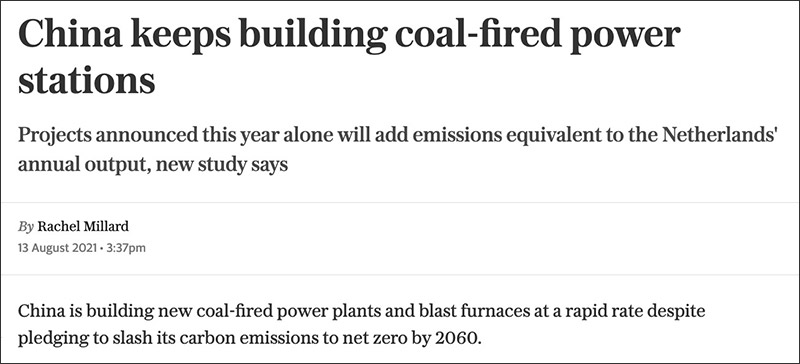
The news from China couldn't be clearer (source: Daily Telegraph, 13 August 2021).
China recently promised (if only vaguely) that it would stop funding more coal-fired power plants abroad.
However, for its own energy supply, it prioritises what its provincial governments called "securing long-term electricity supply".
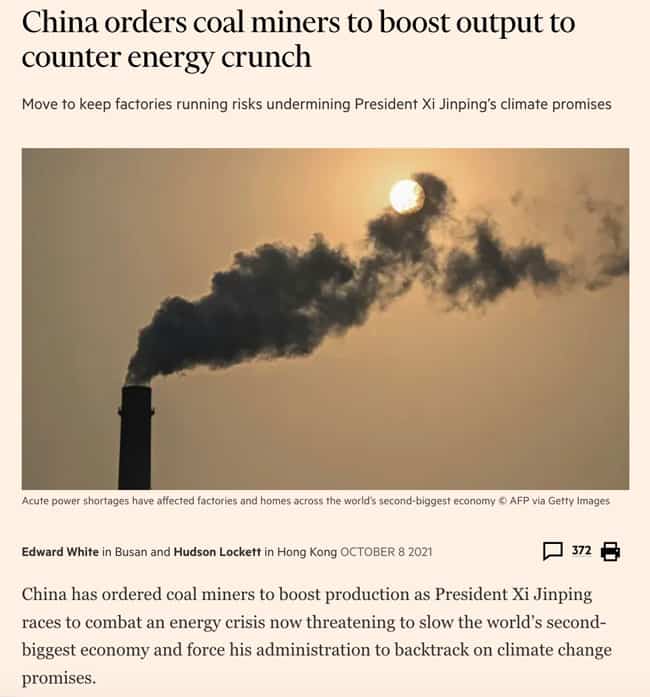
Source: Financial Times, 8 October 2021.
A country wanting to keep its lights on and for prices that its population can actually afford – who'd have thunk? Never mind the issue of Communist China's overall trustworthiness, for which you need to look no further than Hong Kong and the agreement to run the former crown colony under a separate system until 2047.
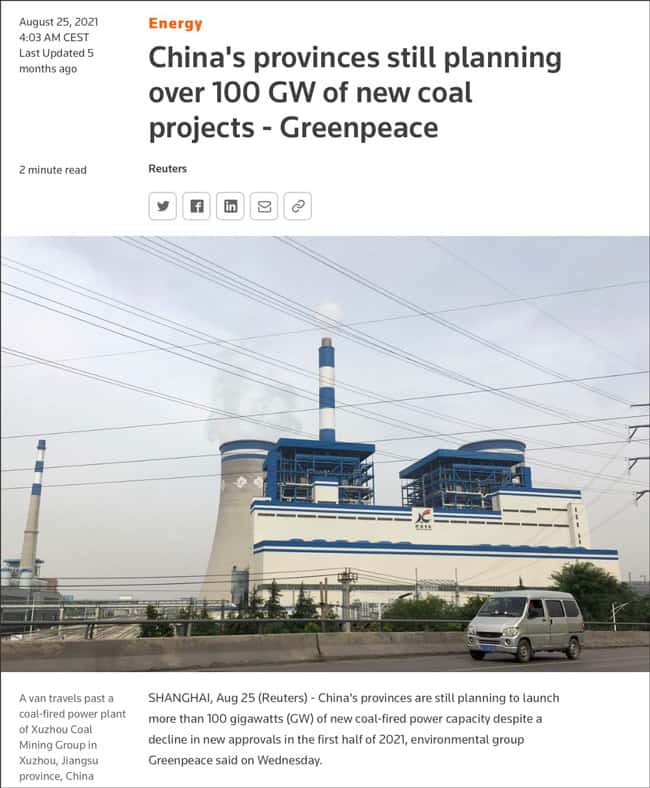
Source: Reuters, 25 August 2021.
Even the Germans still need coal
Much as coal has been getting a bad rap of late, it's the energy that modern civilisation was built on. It fuelled the Industrial Revolution in Britain, enabled the invention of the railway, and (more recently) enabled China's rise from abject poverty to global economic superpower in the space of 40 years. If you live in a modern house rather than a mud hut or a cave, it's because coking coal allows the cheap, plentiful production of steel. Coal has transformed human society for the better, and it has done so over centuries. Its history is beautifully captured in the book "Coal – A Human History" by Barbara Freese.
It has, without a doubt, caused all sorts of problems along the way. Unforgotten is London's Great Smog of 1952, when the city ran on cheap coal for everything from generating power to heating homes. Unusual weather conditions caused the air over London to stagnate, and residents reportedly couldn't even see as far as their own feet. This one incident of smog choked as many as 12,000 people to death, and pollution from the burning of coal continues to be a problem to this day in other parts of the world.

The Great Smog of London.
However, the 1952 event gave rise to modern-day regulation on pollution, and the subsequent decades have seen new technology help make the burning of coal a much cleaner affair, at least in those countries that can afford such technology.
Technological advances are why, to this day, coal is outdone in its use only by oil. The Western world still relies on coal, and to a higher extent than most of us realise (or like to admit). Coal provides the kind of baseload that energy suppliers need to keep the lights on when the wind stops blowing or the sun hides behind thick clouds.
Germany is probably the global benchmark for virtue signalling about its "green" energy transition. Yet, even the Germans are still enjoying the benefits of coal to a higher degree than most observers would think. As Deutsche Welle reported on 13 September 2021:
"Germany: Coal tops wind as primary electricity source
In the first half of 2021, coal shot up as the biggest contributor to Germany's electric grid, while wind power dropped to its lowest level since 2018. Officials say the weather is partly to blame. … A lack of wind from January to March this year sharply reduced the amount of electricity produced by Germany's wind turbines."
This is why some say that so-called renewable energy should really be called intermittent energy, at least for as long as battery technology hasn't caught up yet with the energy demands of developed nations.
The Washington Post provided a clear analysis of the situation in its 23 October 2021 article "Germany portrays itself as a climate leader. But it's still razing villages for coal mines.
Outgoing Chancellor Angela Merkel has been at the forefront of international diplomacy on climate, but Europe's largest economy has struggled to kick its addiction to coal.
Germany has pledged to stop burning coal by 2038, at least eight years behind 16 other European countries that have committed to ending coal use by the end of this decade or earlier. There is some hope that may change as the three parties that made gains in September's elections — including Germany's Greens — hold talks to form a new government. So far they have said they would 'ideally' like to see a 2030 coal exit."
What are the chances of a Western government ever achieving a goal earlier? If you still believe any politicians, please immediately get in contact with me. I have a bridge to sell to you.
The Germans are not alone in their struggle. The Netherlands just announced that they will DOUBLE production from the vast Groningen gas field this year, to make up for Europe's current energy shortfall. Groningen was supposed to be decommissioned entirely at the end of 2022. Given the new situation, what are the chances of this actually happening? For now, at least, the Dutch are refusing to reconsider a change to their decision.
When push comes to shove, politicians are not going to force their population to sit in darkness and freeze. It probably only takes a sustained rise in energy prices to put significant pressure on politics to delay plans for "phasing down" the supply of energy from fossil fuels.
Each country's energy mix is complex, and the international interdependencies even more so. E.g., some were surprised why US president Biden supported cutting back his country's domestic gas production from fracking but wasn't willing to sign up to the COP26 goals to reduce coal consumption. Wouldn't domestically-produced gas be a lot cleaner than coal? One of the several aspects that play into this is that oil and gas are products that nations can easily source on global markets if they run short domestically. Coal, however, is a far more localised industry (its lower energy density relative to its weight makes it less economic to transport across long distances). With a pledge to reduce coal consumption, Biden would have interfered with his country's ability to secure the baseload of energy. Even he didn't dare to mess with the baseload and risk near-certain energy outages.
This doesn't even consider developing countries such as India, where around 200m people still don't have access to electricity. Affordable, reliable electricity makes a difference between hospitals being able to operate equipment and save lives, or people dying unnecessarily and in large numbers. When in doubt, India – and similar countries – will opt to develop their domestic coal resources until they have at least a certain base level of affluence. The public tantrums of a Swedish teenager with mental health issues are unlikely to be relevant to their decisions. Western nations have used coal for turning into affluent societies and so has China, so why shouldn't they? In developing countries, the realities of life reign supremely over fatuous virtue signalling – and many Western countries are currently having similar realisations.
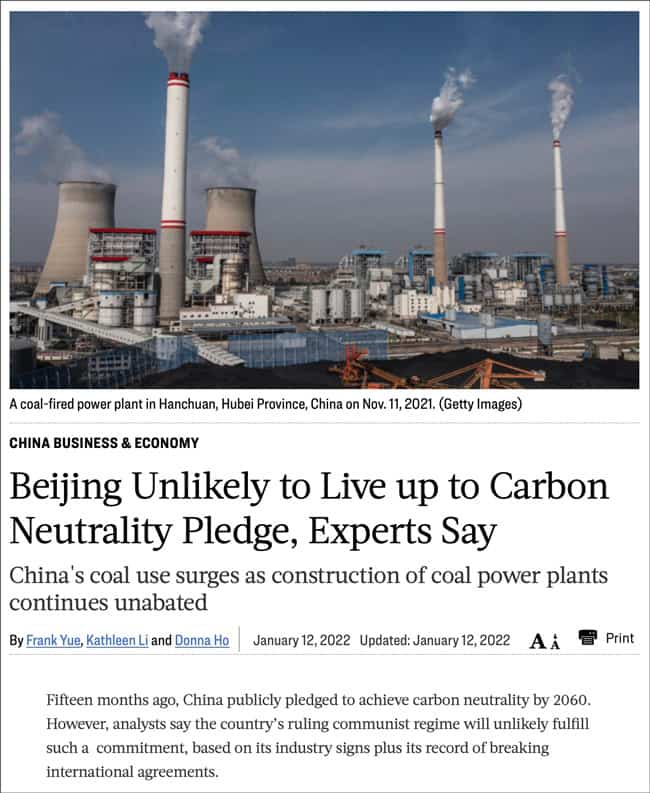
Source: Epoch Times, 12 January 2021.
All evidence points towards coal staying with us several decades longer than is commonly thought. That's not even to mention the paradox that industries with falling demand sometimes experience higher prices and higher margins – a subject for another day. Most of the investing public still hasn't latched onto this, which is why it's so interesting to look at this sector.
The incredible returns from coal projects
The hype machine of the climate change movement has had such momentum in recent years that coal had become almost uninvestable. A Bloomberg report published on 15 July 2021 quoted a response to a survey carried out by the Dallas Fed:
"We have relationships with approximately 400 institutional investors and close relationships with 100. Approximately one is willing to give new capital to oil and gas investment. The story is the same for public companies and international exploration."
The dearth of investment capital has led to returns in the fossil fuel sector going through the roof.
Based on studies by Goldman Sachs, new oil projects now need to offer an annual return of ≈20% to attract capital. That's twice the return the industry had to offer as recently as 2014. In comparison, so-called renewable energy projects have recently been able to raise new funds on the back of a promised annual return of 3%. One is deemed bad and being starved of funds, the other one is deemed good and has investor money chasing available deals.
Nothing beats how the economics of coal projects have changed, though. To raise money for anything relating to coal, investors need to be offered an annual return closer to 40%.
As recently as last year, it was possible to find coal-related companies with price/earnings ratios as low as 2. The past year of rising energy and coal prices has already led to an initial shift in valuations. However, some coal-related companies STILL trade at some of the lowest valuations I have seen in my investing career.
A p/e ratio of 2-4 is – broadly speaking – justified if a company is destined to go out of business within the next five to ten years. If coal hangs around for another decade (or two, or three), then buying at such a valuation can be one of the greatest investment bargains the world has ever seen.
Indeed, we've recently seen as much with the example of Thungela (ISIN ZAE000296554), a coal producer spun off from Anglo American (ISIN GB00B1XZS820). As I reported in my Weekly Dispatch on 8 October 2021, fund managers dumped the stock at fire-sale prices because they were afraid of doing something that's not considered "green". Initially, the stock was trading at less than one year's free cash flow. There were some arguments about potential future liabilities, but on closer analysis these appeared as exaggerated as the COP26 press release headlines. Rational investors who bought when the fundamentals made it a screaming buy made 350% within a matter of months.
Even some of the bellwethers of the coal industry have brought their shareholders massive gains of late. US-American Peabody Energy (ISIN US7045511000), the world's biggest private-sector coal producer, had fallen into Chapter 11 in 2016 following years of losses due to low coal prices. In the years leading up to its bankruptcy filing, the stock had lost 98% in value and the entire company was worth a paltry USD 38m at the end. Following successful negotiations with creditors, the company re-emerged as a listed entity in April 2017. In spring 2021, the stock was trading as low as USD 2.50. Five months later, it had reached USD 20. It's now worth USD 1.5bn.

The world over, there is a surprising number of stocks that are directly or indirectly linked to the coal industry. Even now, some of them can be bought for low single-digit p/e ratios or EV/EBITDA multiples of 2-3. If you know where to look, the sector still offers tremendous bargains.
It also features a number of quirky opportunities, such as GCM Resources (ISIN GB00B00KV284) which I introduced to Undervalued-Shares.com Lifetime Members in April 2020. The company has a massive coal reserve in Bangladesh, and its stock had fallen 99% since its 2005 peak as a result of political controversy. When I first reported about it, GCM was working to develop the resource with Chinese help. China's September 2021 statement about potentially ending the funding of more coal plants abroad has put pressure on the stock, and the entire company is now worth a paltry GBP 7m. However, just three months later, it's already becoming apparent that China left loopholes in its vague promise. E.g., no fewer than eight new coal-based energy projects in Indonesia are powering ahead with Chinese funding, based on the latest reporting. If GCM's coal reserve was developed after all, the stock price could multiply from its extremely low base. It's a highly speculative stock and highly volatile at times, but it could turn into the kind of investment that others rub their eyes over if it staged a turnaround.

Down and out – but will it stay that way?
I have recently been combing through the coal sector in general and publicly listed coal companies in particular.
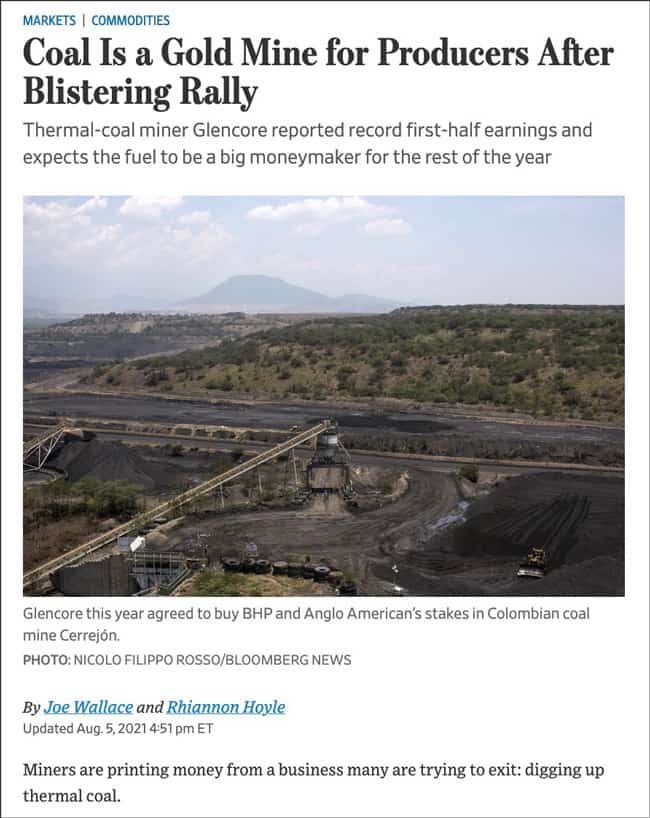
Source: Source: Wall Street Journal, 5 August 2021.
To me, it's pretty clear what's likely going to unfold over the next couple of years:
- Politics will have to concede that it gave in to excessive demands and expectations about phasing out coal. The use of coal will be "phased down" rather than "phased out", and at a slower pace than expected because alternative forms of energy are simply not ready yet. No elected politician will want to see the lights go out, and even the green energy obsessed corporate media reacts negatively when an energy company condescendingly suggests its freezing customers to "cuddle the pet to keep warm". Both Germany and France were already forced to bring decommissioned coal-fired power plants back into operation, which says everything. A new form of energy realism is likely to set in over the next one to two years. Coal production for energy is likely going to stay a significant part of the world's energy mix well into the 2040s, albeit with regional/national variations. The recent initial resurgence of some coal stocks is the beginning of a longer-term turnaround rather than a dead cat bounce.
- Instead of trying to drain the coal sector of all investment, there'll eventually be a focus on developing the best available coal reserves in the least environmentally damaging way. Like with oil, some coal is cleaner than other. Also, with more investment, technology to make coal as clean as humanly possible could once again be driven forward. Modern "HELE" (high-efficiency, low emissions) coal power plans can also capture particulates such as sulfur and NOx. Politics would be well-advised to focus on a "phase in" of the cleanest available power plants in locations where energy production still relies on outdated equipment, instead of chasing abstract goals for the year 2060. Other quick wins could include helping developing countries phase out burning coal for home cooking and heating, which is something that coal companies could support financially. Coal will be invited back in from the cold because the world simply cannot afford not to and running out of energy makes people regain their senses. China is ahead of the game, also in terms of marketing itself. Just watch the recent video that China had published about the country's most advanced coal power plant. Which Asian consumer would object?

A Singaporean TV channel about China's self-proclaimed "cleanest coal power plant in the world" (source: CNA Insider, September 2018).
- The language around the entire subject will change. Now that the public is realising the consequences, the so-called climate change movement will have to gradually replace its extreme rhetoric with a rational, realistic approach. The oftentimes mislabelled "green" bonds will eventually be replaced with something like "transition bonds", i.e. financial products that are honest about the inevitable long duration of energy transitions. As my blogging colleague Lyall Taylor of LT3000 summarised in an epic post on 7 November 2019 ("Contrarianism; ESG investing; coal; and climate change"): "…the world is not black and white, but instead shades of grey, and is filled with infinite nuance and complexity, and as a result, future outcomes will routinely surprise mainstream popular opinion informed by overly-simplistic generalisations and thinking in absolutes." As part of that, well-managed coal projects for which there are no viable alternatives will see an influx of new investment capital and coal-related stocks will see multiple expansion as a result of becoming more widely accepted again.
We might even see those who contributed to the current energy crisis held accountable. The Martens Centre for European Studies alleged that European "environmental" NGOs received USD 95m in funding from the Russian government to lobby against the use of European gas reserves (and instead make Europe dependent on Russian gas imports). If true, one has to ask why European NGOs were allowed to lobby on behalf of a known adversarial power and damage the financial and social interests of their domestic population? This crisis could help flush out a lot of what is wrong in Europe, in particular.
We've recently seen an incredible about-turn with regard to the use of nuclear energy, and something similar is likely to happen with a rational, targeted use of coal.
For years (decades, even), the so-called environmental movement has castigated nuclear energy as an unacceptable form of energy that was to be phased out. Now, we have the European Union working to relabel nuclear energy as "green energy". This chimes with Bill Gates' book "How to Avoid a Climate Disaster", which identified next-generation nuclear energy plants as vital for the world's transition to new forms of energy production. The price of uranium, long a neglected and low-priced commodity, has recently been soaring as a result. London's free daily newspaper Evening Standard featured an article on 6 January 2021 advising investors to "Electrify your portfolio by going green", including buying nuclear power stocks.
Will coal stage a similar comeback?
I think it probably will.
Mass hysteria, moral panics, and extremist movements peddling utopian visions only ever last for so long (the latter usually until they run out of other peoples' money; or in this case, energy). In the long run, the stark facts of day-to-day reality reign supreme. For now, this reality is that coal is a much-needed energy source that will stay with us for another generation. My expectation, based on recent developments, is that the world will recognise this over the coming years. As seen by some of the examples above, the returns for investors when money starts to flow back into the sector can be staggering. There is even a strong social aspect to it, given that a company like Thungela employs thousands of working class Africans who would otherwise have no job prospects. Just as nuclear is now being rebranded to make it a tasty investment for the "ESG" crowd, coal could yet make a comeback as a must-own investment for those who are pro-humanity.
Rest assured, I have a number of coal-related investment opportunities on my radar, which I'm going to share with Undervalued-Shares.com Members when the timing is right. Until then, if you wanted an IMMEDIATE idea relating to fossil fuels and its extraordinary returns, I recommend you check out the following...
"Why it's time to love oil stocks again"
What's true for coal is just as true for oil.
Oil is not going to see its peak before 2035, and possibly not even until 2045. And that's just the peak, never mind the subsequent continued use of a smaller amount of oil. Until then, those countries that are honest about the situation are going to make a fortune. Brazil, anybody?
The country's national oil champion, Petrobras (ISIN BRPETRACNPR6), has recently announced record investments to exploit the worsening global demand/supply imbalance. Its so-called "pre-salt" oil reserves are likely to gain a lot of attention, as they are much less damaging to the environment.
It'll be for the good of Petrobras shareholders. Between 2022 and 2025 alone, Petrobras is planning to pay dividends totalling over 100% of the current share price. For 2022 alone, the dividend yield could come out at ≈30%.
I have analysed all this in detail in my latest research report for Undervalued-Shares.com Members.
Petrobras: time to love oil again
I've said it before, and I'll say it again: not owning fossil fuel energy stocks in 2022/23 could turn out to be the biggest drag on your portfolio.
Brazil's national oil producer, Petrobras, is the sector's hottest candidate right now.
It's one of the world's cheapest blue chip stocks, and it's trading at a record-low 2.4 times EV/EBITDA multiple. Oh, and did I mention the dividend payout that the company is planning between 2022 and 2025 (>100% of the share price)?
A terrific income investment with a sky-high annual yield.
Petrobras: time to love oil again
I've said it before, and I'll say it again: not owning fossil fuel energy stocks in 2022/23 could turn out to be the biggest drag on your portfolio.
Brazil's national oil producer, Petrobras, is the sector's hottest candidate right now.
It's one of the world's cheapest blue chip stocks, and it's trading at a record-low 2.4 times EV/EBITDA multiple. Oh, and did I mention the dividend payout that the company is planning between 2022 and 2025 (>100% of the share price)?
A terrific income investment with a sky-high annual yield.
Did you find this article useful and enjoyable? If you want to read my next articles right when they come out, please sign up to my email list.
Share this post:

